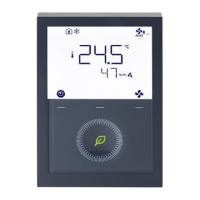The CO
2
control takes precedence (higher priority) over temperature control.
The room temperature setpoint may not be maintained during active CO
2
control
depending on the size of the HVAC system.
Check sizing and balancing if this is the case. The CO
2
setpoint (and P-Band) can
be increased as an alternative.
RDG2..4KN uses a maintenance-free CO
2
sensor.
The ASC (automatic self-calibration) algorithm maintains an accurate CO
2
reading
over time when the thermostat is regularly exposed to the fresh air (400 ppm). As
is the case in well-ventilated buildings over night without human presence or when
windows are opened. The thermostat must always be powered. Powering off and
on the device may result in wrong CO
2
indications for several days and delay ASC.
The DC damper is connected to multifunction output U1. For those applications, U1
is not available as a multifunctional input (P155).
The CO
2
sensor is very sensitive to mechanical force. Avoid as much as possible
mechanical shocks, drops or vibrations during transport or installation, which could
cause a noticeable CO
2
deviation after installation. When this occurs, we
recommend waiting up to 2 or 3 weeks before retesting the CO
2
measurement.
4.6.12 Power reserve clock (RDG2..T)
When the thermostat detects a power failure, all parameters and customer settings
(time program, operating mode, setpoint and fan speed) are saved internally and
the display switches off.
The clock continues to run during power failure. The display switches on once
power resumes. The thermostat reloads the previous settings and continues to
operate with the correct clock time.
The correct time clock must be set manually on the thermostat if the power failure
exceeds the maximum backup time.

